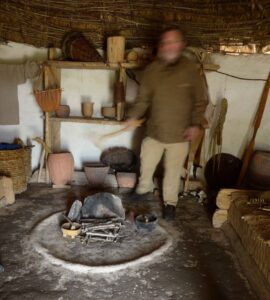
As you know one of my interests lies in the nature of archaeological truth.
Actually, I don’t believe that there is any such thing as ‘truth’ in archaeology – we can no more be certain of the motivations, or even the actions, that took place in the past, than we can of the reasons behind the things we did yesterday. But when we are writing we are all, as archaeologists, aware of this. Or are we? Given this lack of definitive proof we have to accept that without supposition there would be no archaeology. But we have to learn how to use it properly. I think we have fallen into an archaeological shorthand that means that instead of saying: ‘the possible Neolithic houses at the site that we interpret as a village and which we call today Skara Brae’, we say: ‘The Neolithic houses at the village of Skara Brae’. Archaeological readers, we hope, will understand the caveats that go into any archaeological statement.
With this in mind, most authors will, at some point, preface their books with a statement to the effect that the interpretation presented may well change in the future. I don’t think most people have a problem with this – they accept that any discipline moves forward and the popular media keep people well aware of the advent and benefits of new archaeological techniques. When they were putting together the interpretive displays at Skara Brae, David Clarke and Pat Maguire tried to get around the issue of highlighting speculation by explicitly using a normal font face for ‘fact’ and italics for ‘supposition’. This works well – it looks good and does not prevent people from reading the text, but I wonder how many people have read enough to be aware of the reasons behind the change in type face?
Sometimes when we are working with non-archaeological colleagues, or those new to the profession, it can be more complex. When I was a recent graduate I felt strongly that because we could not verify the functional names we gave stone tools, like arrowhead, and because many pieces probably had multiple functions, we should eschew those functional names for more neutral terms. I was probably a bit of a pain about it. Over time, I realised that people did hold a more nuanced view of the terminology than I gave them credit for and I gradually relaxed. Now that I am older I find that the tables are turned and it is my turn to explain my use of traditional terminology.
One element of this that make me curious is the way that people fixate on some elements of our archaeological interpretation to the exclusion of others. Words such as ‘ritual’ or ‘ceremonial’ are guaranteed to raise the hackles of the interpretive purist, whereas they are much more likely to let terms such as settlement, or burial, go by unnoticed. To me these are equally laden. The ‘tombs’ of Neolithic Orkney seem to have been designed for so much more than simple disposal of the dead. And one of my personal bugbears is the unqualified use of ‘settlement’ when really we have no idea what went on. How do we define settlement even when it does involve an over night stop – could the camp-site that results from a group of 14 year olds celebrating the summer solstice be called a settlement? Is it domestic? I find that I am constantly seeking alternatives that are less value-laden – such as the bland ‘activity site’, or even ‘occupation’, when I am working on Mesolithic material. But then, of course, I don’t have burial sites or even many possible ceremonial sites, to worry me in Mesolithic Scotland.
Are we getting lazy at writing, and slow to re-examine the evidence for our deeply held beliefs? Possibly. Perhaps we are not good at welcoming new people into the profession and listening to what they have to say. We are certainly guilty of presenting unfounded suggestions as ‘gospel truth’. But, of course, we are just telling stories. We all need to remember that.
You must be logged in to post a comment.